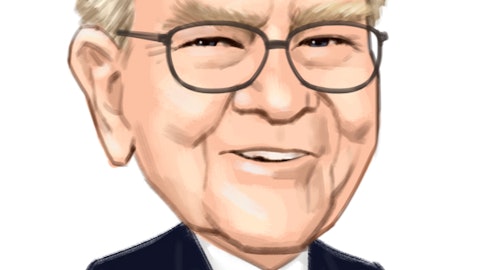Mike Cikos: Understood. Thanks for calling that out, Mike.
Operator: Thank you, Mr. Sikos. Our next question is from Patrick Walravens with JMP. You may proceed.
Owen Hobbs: Hi, this is Owen Hobbs on for Pat. Thanks for taking the question. Congrats on the strong quarter. So starting off, I guess, how much consumption comes from the different hyperscalers? Is there 1 that kind of is it split evenly between the three or does kind of have the majority of compute share there?
Mike Scarpelli: No. AWS by far is our biggest, followed by Azure and then GCP. GCP is up to 3% right now. Microsoft Azure is the fastest-growing one, but AWS is still 76% of our business with Microsoft being 21%. As I said, GCP is 3%. And I will tell you, 1 of the reasons why GCP is not as big as just so much more expensive for our customers to operate in GCP than it is in AWS and Azure. And as a result, our salespeople are really not inclined to do much in GCP.
Owen Hobbs: Thank you. And then going bigger picture, maybe this is a question for Christian as well. How is the role of the data scientist you sort of kind of changed as we move through the era of big data, machine learning and now into AI? And I guess where do you see that going in the future?
Christian Kleinerman: Yes. We see actual interest on both the traditional data science and ML platform. And we’ve had a number of announcements at Snowflake for those such use cases, but we obviously see lots of interest on generative AI and large language models where we have also expanded obviously capability to do both hosting via Snowpark Container Services, but more seamless inferencing via the new Snowflake Cortex. So we see strong demand from our broad customer base for both types of use cases.
Owen Hobbs: Good. Thanks so much.
Operator: Thank you, Mr. Walravens. Our next question is from the line of Gregg Moskowitz with Mizuho. You may proceed.
Gregg Moskowitz: All right. Thank you very much. Frank, since you speak with a lot of large company execs, I’m curious to hear any thoughts you have on IT budgets next year as well as whether there will be incremental budget dollars approved for AI in calendar ’24 or if the AI spend will primarily or maybe even entirely come from other areas of IT?
Frank Slootman: I don’t even hear the words AI and budget in the same sentence. In other words, they’re going to make resources available to enable it. But if anything is holding them back is really understanding how to do it. It takes time in tech to mature and evolve deployment architectures where everybody involved is fully confident and comfortable that these are the right ways to do it. So you see a lot of benchmark and compare and contrast experimentation, testing all these kinds of things. And they’re going to go through many, many iterations of that. We will as well. And I think that the field will become very proliferated with large foundational models and many, many, many subsector specialized models that are very, very, very deep, but also are very, very narrow in purpose.
So it is going to become an enormous field. I will tell you that when you talk to the C-suite in large enterprises, people are looking for a reset of economics, like, for example, in contact centers, pricing optimization, supply chain management, I mean, really very, very big impact opportunities. These are not sort of marginal incremental and that has the attention. Data has always had a promise, but it’s really on steroids now under the influence of the newer technologies that we’re all excited about.
Gregg Moskowitz: Very helpful. And then for Mike, really encouraging, of course, to hear that for three weeks, consumption grew faster than any other period over the past two years. Over which three weeks though, did you see that particularly strong consumption? Was that post Labor Day? Or did it span a different time period?
Mike Scarpelli: Post Labor Day.
Gregg Moskowitz: Right, Perfect. Thank you.
Operator: Thank you, Mr. Moskowitz. Our last question is from the line of Will Power with Baird. You may proceed.
Will Power: Okay, great. Thanks. Mike, you referenced that nine of your top 10 customers, it sounds like we’re nicely quarter-over-quarter. I guess I wonder, were there any common use cases or products or common threads kind of driving that? Any other color behind the strength there?
Mike Scarpelli: No, these are just all very large customers with massive data estates that continue to — one was doing a big migration, but the others are just continuing to move workloads to Snowflake.
Frank Slootman: That’s very industry-specific as well.
Will Power: Okay. And maybe just a quick question on product gross margins. Last couple of quarters, you’re kind of already at your longer-term target, I think. It sounds like there may be a couple of headwinds there in Q4, but is this kind of the general level to expect going forward? And maybe any color on kind of the upside surprise, I guess, if you will, given it seems like you’ve gotten there faster than you might have expected?
Mike Scarpelli: Yes. I don’t really see a lot of upside in our long-term guidance and for a number of reasons. The big headwind that we’re seeing this quarter to our margin is with all these new products, that are going into public preview. We have to start to amortize the costs associated with the software development costs that we’re required to capitalize under GAAP that are now going to start to be amortized on top of that. In particular, something like Unistar, a lot of times when we introduce new products, many times, we actually have negative contribution margins until it takes us usually up to half a year to nine months to actually fine-tune the software to get the — to take costs out of operating those new features. And so we just have so many new products that are coming out this quarter that is going to have a headwind on the margin.
Will Power: That’s helpful. Thank you.
Operator: Thank you, Mr. Power. That concludes the question-and-answer session as well as today’s call. Thank you for your participation. You may now disconnect your lines.
Follow Intrawest Resorts Holdings Inc. (NYSE:SNOW)
Follow Intrawest Resorts Holdings Inc. (NYSE:SNOW)
Receive real-time insider trading and news alerts





